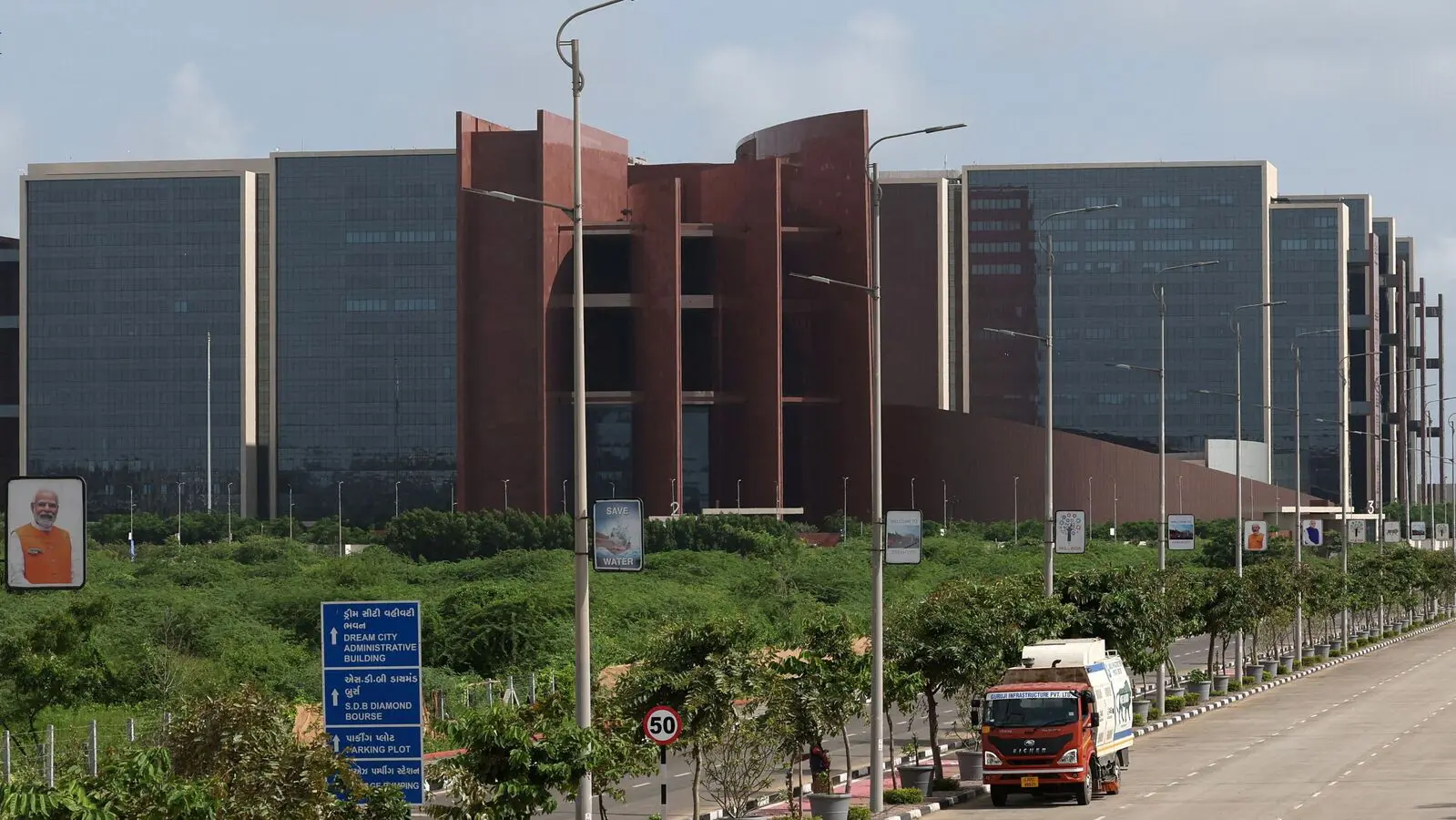Surat: The Surat Diamond Bourse, touted as the world’s largest office complex, faces a major downturn in its diamond trading activities due to sluggish business and economic uncertainties. Exports from India’s diamond industry are at a two-decade-low, significantly impacted by weak demand from China and higher tariffs imposed by the U.S. Amid this grim situation, the local market is restructuring, bracing for a potentially catastrophic impact on employment and operations.
Diamonds in Decline: Surat’s Economic Struggles
Surat, a thriving metropolis in Gujarat, is internationally recognized as the cutting and polishing hub for rough diamonds, managing over 80% of the world’s supply. Despite its towering bourse symbolizing India’s trade ambitions, the complex now stands mostly vacant, with only a handful of traders actively conducting business. With exports from the diamond industry hitting a 20-year low, concerns loom larger as demand from China falters and tariffs imposed under the U.S. administration threaten to disrupt trade routes critical for Indian exporters.
In fact, U.S. tariffs have the potential to double, escalating from 25% to 50% by August 27. This impending shift is likely to severely affect the country’s $28.5 billion annual gem and jewelry shipments, putting immense pressure on businesses relying on the American market, which accounts for nearly a third of their exports.
Shifting Operations: A Matter of Survival
Faced with these challenges, many larger companies, such as Dharmanandan Diamonds, are contemplating relocation of operations to more favorable environments, like Botswana, which currently has a 15% U.S. tariff. “We are in a wait-and-watch mode until the end of August but may increase production in Botswana if this continues,” said Hitesh Patel, managing director of the company. This strategy of moving operations abroad not only reflects the seriousness with which companies are approaching this economic crisis but also signals a potential long-term shift in the global diamond trade landscape.
For smaller exporters, the options are even grimmer. As business slows, many firms are reducing workforce hours or even letting go of staff. Shaunak Parikh, vice chairman of the Gem and Jewellery Export Promotion Council (GJEPC), shared that the industry is adjusting by cutting down working days and hours in response to dwindling demand— a clear signal of the current economic distress faced by the sector.
Sparse Bourse: Empty Offices and Uncertain Futures
The Surat Diamond Bourse, a colossal structure comprising over 4,700 offices, now showcases a stark contrast to its envisioned bustling future. With less than 250 offices actively in use, several companies have rethought their plans to relocate or establish themselves in the bourse, highlighting the disillusionment spread across the community.
One diamond firm from Mumbai, having previously purchased office space in the newly inaugurated bourse, has now shelved its plans to move. Citing U.S. tariffs as a significant deterrent, the firm’s owner explained, “U.S. tariffs have already shaken our business, and we don’t want the added hassle of moving from Mumbai to Surat.”
This state of uncertainty has produced a wait-and-see attitude across the industry, leading to stagnant growth where the bourse was intended to serve as a symbol of prosperity.
Hope for Domestic Demand Amidst Global Decline
Despite international challenges, there is a silver lining for the diamond industry within India. Recent statistics indicate that domestic demand for diamonds has continued to grow, as India recently surpassed China as the world’s second-largest diamond market. Hitesh Shah, a partner at Venus Jewel, noted, “Our sale for the last 10-15 days has slowed down a little but not that much because the loss of American demand is being compensated by some good demand in the Indian market.”
This internal growth presents an opportunity for diamond exporters to shift their focus towards local markets, potentially alleviating pressures stemming from foreign trade problems.
Job Losses Looming in the Industry
However, the diamond industry cannot ignore the looming threat of job losses, with estimates suggesting that between 150,000 and 200,000 workers may be displaced if the trade tensions continue without resolution. As companies cut rough diamond purchases and operate with minimal inventories, the chances for economic recovery remain uncertain. Smaller units, finding themselves cash-strapped, have begun offering deep discounts to maintain their market presence, thus exacerbating the industry’s struggle for survival.
While the Surat Diamond Bourse stands as an ambitious venture for India’s economy, the current conditions depict a sector in distress—one that must adapt rapidly to survive in a changing global landscape. The story of Surat is not just about diamonds; it’s a testament to resilience, adaptation, and the urgent need for strategic shifts in an increasingly unpredictable market.
💡 BankerPedia’s Insight
Generate a thoughtful, **150–200 word** expert commentary that explains the significance of this news, practical implications, and clear guidance for readers. Tone should be human, expert, and simple (guiding). **Do not** reproduce the instructions, placeholders, or the article text verbatim. Output only the commentary paragraph (between 150 and 200 words). Do not include sub-headings or extra HTML tags inside this paragraph.
🤔 What Does This Mean for Me?
- Salaried Person → [One-line impact tailored to this article, no quotes]
- Business Owner → [One-line impact tailored to this article, no quotes]
- Student → [One-line impact tailored to this article, no quotes]
- Self-employed → [One-line impact tailored to this article, no quotes]
- Homemaker → [One-line impact tailored to this article, no quotes]
- Retiree / Senior Citizen → [One-line impact tailored to this article, no quotes]
- Job Seeker → [One-line impact tailored to this article, no quotes]
- Farmer / Rural Citizen → [One-line impact tailored to this article, no quotes]
📚 Research References
- www.livemint.com
- RBI
- SEBI
- Ministry of Finance
- NABARD
- Department of Financial Services (DFS)
- LiveMint
📲 Stay ahead in banking & finance!
Join the Bankerpedia WhatsApp Channel for instant updates, and
subscribe to our YouTube Channel for in-depth analysis and expert explainers.
”










